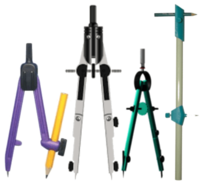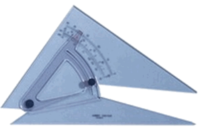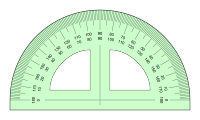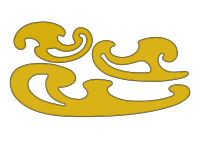Drawing Instruments
From DT Online
Drawing, in its various forms, is the most common way of communicating ideas in Design and Technology. Free-hand Sketching helps the designer to work out initial ideas and to share them with others. Sketches can be in Perspective or follow one of the more formal Technical Drawing conventions such as Isometric, Oblique or Orthographic.
Sketching is a very quick and free way of working out ideas and all those involved in Design and Technology are encouraged to develop this skill - it only takes practice!
Use of rulers and compasses can help by providing a guide lines for example, but when a design is finalised and a drawing has to be produced which can be measured off, Drawing Instruments are used to create detailed Working Drawings or Plans.
Modern industrial practice has largely replaced the production of Technical Drawings by Draughtsmen working at a drawing board with Computer Aided Design (CAD) but this is still based on Technical Drawing techniques and conventions.
| Drawing Pencil | Pencil leads are graded according to their ‘ hardness’ (H) and ‘blackness’ (B) by varying the mix of Graphite and Clay - a 2H pencil is useful for Technical Drawing, HB is the common writing grade and a 2B pencil is good for shading pencil sketches. The body of good quality pencils is made of Cedar and this can be indentified by the distinctive scent released when the pencil is sharpened.
Note: Always try to use a full length pencil for best control when drawing or sketching and keep it sharpened. |
|
| Compasses | Used for drawing arcs and circles, these range from simple Pencil Compasses to the more precise instrument used in Technical Drawing. As drawing instruments they can have Knuckle Joints to ensure the pencil lead maintains an Acute Angle to the drawing surface and Springbow compasses use a fine screw for adjustment. | |
| Beam Compasses | Used for larger diameter circles | |
| Trammels | Similar to Beam Compasses but commonly associated with larger tools used for setting out constructional work rather than drawing. | |
| Dividers | Used to transfer measurements and similar in all respects to Compasses but with a stylus point on each leg. | |
| T-square | A drawing instrument comprising usually a plastics blade and stock made also of plastics or wood which is pressed against the edge of a drawing board to enable parallel lines to be drawn across. | |
| Set Squares | Triangular shaped Drawing Instruments usually used in conjunction with a T-square or rule to draw lines at 45, 60, 30 and 90 degrees to it. | |
| Adjustable Set Square | Can be set at any angle to draw a series of parallel lines for example. | |
| Protractor | Used for measuring angles and available in 180 degree and 360 degree versions | |
| French Curves | A set of templates of curved shapes used for drawing curves through a series of points |







